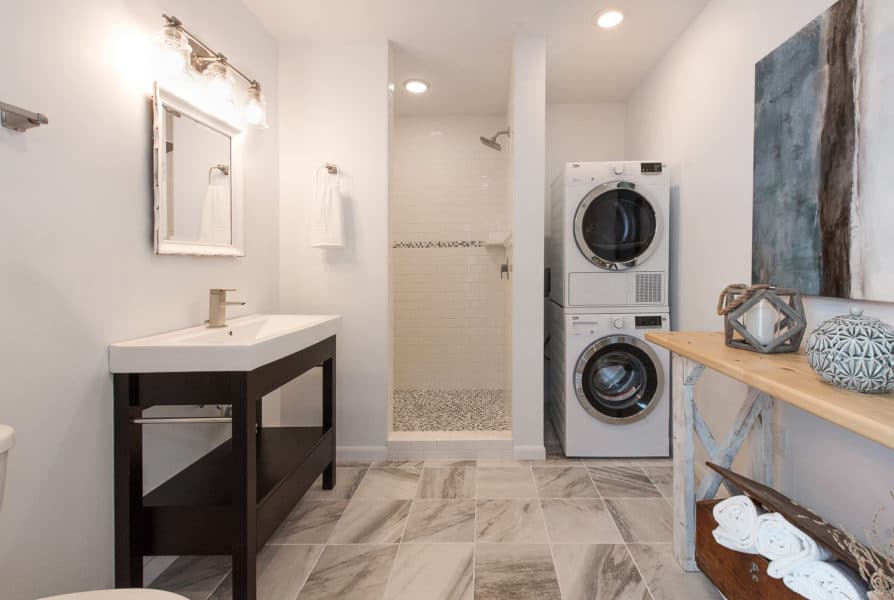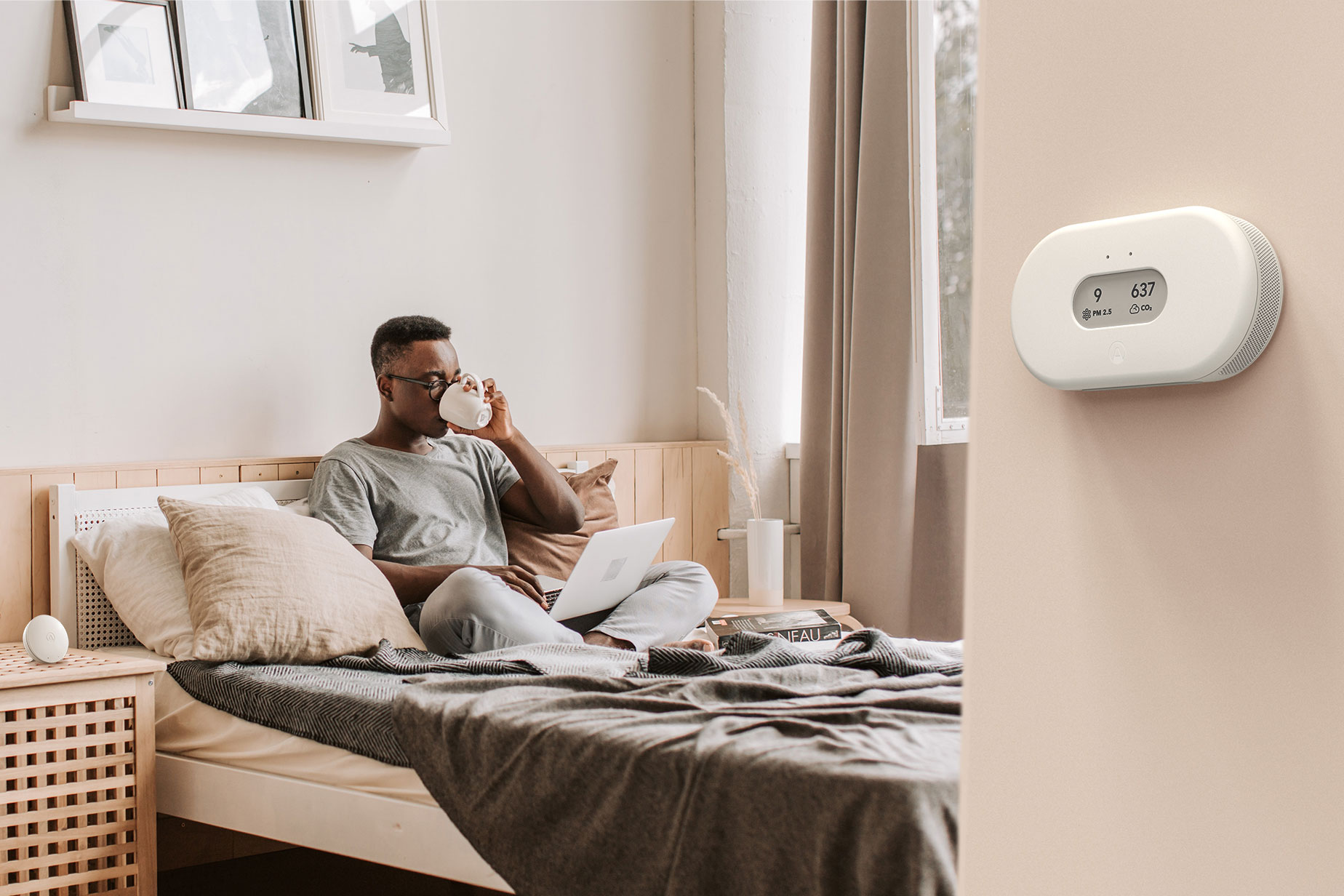Story at a glance:
- Carbon dioxide is an odorless, colorless natural gas that can be hard to measure without the proper tools.
- A home with an efficient HVAC system can help mitigate CO2 trapped in the air.
- Limiting open flames, adding plants into your home design, and more can help keep the air clean.
Spending more time at home these days means we may be noticing things we didn’t see before: a crack in the wall, a slow drain. But one thing you probably won’t notice: rising carbon dioxide levels.
Carbon dioxide, or CO2, is an odorless, colorless natural gas that is released into the air when we breathe. Although CO2 is harmless in small quantities, the buildup of this natural gas can lead to adverse health effects such as fatigue, headaches, loss of concentration, dizziness, shortness of breath, increased heart rate, and more.
So how can you improve indoor air quality? Here are some easy fixes that can help lower CO2 levels and reduce air pollution in your home.
1. Ensure your HVAC system is working properly.
Let’s get the obvious out of the way first: Check your HVAC system, be it a radiant system or forced air. Many efficient ventilation solutions recycle air to conserve energy, which is great for the environment but can move contaminated air around rather than cycling in new air, which can lead to a higher concentration of CO2. Replace your air filters and any other parts as needed to improve ventilation and lower CO2 levels in your home.
2. Design your home to support airflow.
As buildings become more airtight, less fresh air is circulated around your home, and air confined to one space keeps CO2 trapped. Other than a strong ventilation system, think about how to set up your home to keep air moving. Consider opening your windows when you can and placing big furniture pieces against the wall rather in the center of a room, where they can block airways. At night, keep bedroom doors open so air can filter through while you sleep.
3. Limit open flames.
Chestnuts roasting over the open fire is great come the holiday season, but fire uses up the oxygen in your home and replaces it with CO2, so be cautious of how often you light a fire or a candle. Similarly, smoking also releases large amounts of CO2, along with other chemicals, which then get trapped in your home.
4. Incorporate indoor plants.

COOKFOX designed the new IWBI offices in New York City with an emphasis on biophilic design. Photo by Eric Laignel
Plants not only boost your mood, concentration, and creativity—not to mention provide stress relief—but greenery also helps purify the air by converting CO2 into oxygen and absorbing toxins. Red-edged dracaena, weeping fig, and bamboo palm are among the best indoor plants due to their air filtering capabilities. COOKFOX designed the new IWBI offices in New York City with an emphasis on biophilic design, including plentiful indoor plants, as pictured.
5. Invest in an air purifier.
Plants might be nature’s air purifier, but sometimes they need a boost. An air purifier with activated carbon filters and a fan can help capture pollutants from the air and improve air quality.
Air purifiers range in capacity—some are built to cover a 3,000-square-foot home, others only a small room. Make sure to use an air purifier fit for your indoor space, and don’t forget to change the filters regularly to keep air fresh and clean.
High-end air purifiers and monitors can also track CO2-related markers.
6. Increase airflow while cooking.
Another way CO2 is released into the air is through combustion, which is common in cooking, particularly with gas ranges. Turning on an extractor fan can expel CO2 and other gases that form while cooking, such as nitrogen dioxide, outside. If you don’t have an extractor fan, open a window to keep air moving.
7. Limit your exposure to VOCs.
Besides carbon dioxide, other carbon compounds called volatile organic compounds (VOCs) can also linger in the air. Unfortunately VOCs can be hidden in many everyday materials, furniture, cleaners, and more. For example, VOCs from interior paints continue to off-gas for months or even years after the fresh paint smell disappears. When you can, opt from products made from natural materials and ingredients, such as nontoxic paint.
8. Watch your home’s humidity levels.
Moisture in the air can help prevent coughing and nosebleeds, but too much moisture and issues like harmful mold growth can arise. The ideal relative humidity for your home should be between 30% and 50%, according to Mayo Clinic. To reduce extra moisture in the air, cover boiling pots and pans, turn a fan on during hot showers, and keep windows open while cooking to limit extra condensation.
9. Minimize rug use.
Particle buildup in rugs and carpets means that pollutants can get trapped in fabric fibers. Choosing hard surface floors, such as hardwood, bamboo, or tile, can prevent that buildup. If your home is carpeted, make sure to vacuum regularly.
10. Pick up a CO2 monitor.
Because carbon dioxide is odorless and colorless, it’s tricky to track. A CO2 monitor will tell you exactly how much carbon dioxide is in the air and when you should take steps like those above to lower the CO2 levels in your home.
11. Avoid smoking indoors.
Cigarettes release large amounts of CO2 that can get trapped inside the room for a long time. If you must smoke, do so outdoors, as smoking indoors reduces the level of oxygen in the home and increases the amount of CO2. CO2 levels in cigarette smoke are 200 times the levels in the atmosphere.
12. Use energy-efficient appliances.

Photo courtesy of Beko US
Energy-efficient appliances can greatly help you reduce your carbon dioxide emissions in the house, as you avoid burning fossil fuels and further releasing carbon dioxide. Using energy-efficient appliances like dishwashers and refrigerators help save energy that can also help reduce the greenhouse gas emissions and protect the environment.
Beko US is making appliances way more efficient. When you use a product like Beko US’s ventless heat pump dryer, you’re using a lot less energy—and that’s all part of the company’s commitment to energy efficiency. “Eliminating the need for a high-temperature drying process, thus resulting in a non-fabric damaging operational temperature, is one of the key benefits of the heat pump technology,” Salih Zeki Bugay, director of product management at Beko US, previously told gb&d. “Thanks to the lower temperature operation, fibers are not agitated and lint formation from the drying process is reduced considerably.” More than 90% of Beko’s major appliances are Energy Star certified.
What is a good to acceptable CO2 level for a home?
CO2 at very high concentrations (e.g. greater than 5000 ppm) can pose a health risk, according to ASHRAE. A level of 350 to 1,000 ppm is typical in occupied spaces with good air exchange, according to IndoorDoctor.com.
From 1,000 to 2,000 ppm you can expect drowsiness and poor air, and from 2,000 to 5,000 ppm headaches, sleepiness, stagnant and stale, stuffy air are reported with complaints of poor concentration, loss of attention, increased heart rate, and slight nausea possible. A CO2 level higher than 5,000 ppm may lead to serious oxygen deprivation symptoms.
How do I know if CO2 is high in the house?
Shortness of breath, dizziness, exhaustion, headaches, and a nauseous feeling are all signs that the CO2 levels inside a home may to be too high.
CO2 monitors can help you determine whether the levels in a house are safe. Airthings hopes to make buildings a little bit healthier with products like their View Plus—an easy-to-use indoor air quality monitor that tests for carbon dioxide, VOCs, humidity, virus risk, and more.
“We monitor so many classrooms around the world. You see people sitting with several thousand PPMs of CO2, which means their cognitive performance is lowered by 20, 30, or even 40%,” says Airthings CEO Øyvind Birkenes. “They’re drowsy. They’re tired. Awareness around that has increased.”
Outdoor air quality should also not be dismissed, as you could be letting bad air in on certain days. The AQI index allows you to easily check the quality of air outside every day.
Conclusion
Of course, carbon dioxide is around us all the time. It’s important to remember that in large quantities, upwards of 1000 ppm, sources of carbon dioxide in the home can affect your health and well-being. Being aware of the sources of carbon dioxide in your home can help maintain harmless levels of CO2.
Laura Rote contributed to this article.



